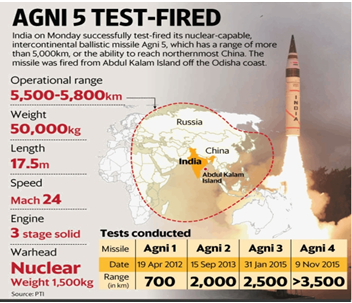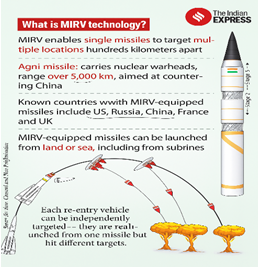

21st August 2025 (21 Topics)
Context:
India on Wednesday successfully test-fired its intermediate-range ballistic missile Agni-5 from the Integrated Test Range at Chandipur, Odisha
Agni Missile Programme

- The Agni missile series is part of India’s Integrated Guided Missile Development Programme (IGMDP) launched in the 1980s under Dr. A.P.J. Abdul Kalam.
- They are surface-to-surface, nuclear-capable ballistic missiles developed by DRDO to strengthen India’s credible minimum deterrence under its nuclear doctrine.
- The series provides India with a triad-based deterrence strategy, complementing air and sea-based delivery systems.
Classification of Agni Missiles
|
Missile |
Range |
Stages / Fuel |
Key Features |
|
Agni-I |
~700–1,200 km |
Single-stage, Solid fuel |
Short-range ballistic missile |
|
Agni-II |
~2,000–3,000 km |
Two-stage, Solid fuel |
Medium-range capability |
|
Agni-III |
~3,500 km |
Two-stage, Solid fuel |
Can strike deep into China |
|
Agni-IV |
~3,500–4,000 km |
Two-stage, Solid fuel |
Enhanced accuracy, advanced navigation & guidance |
|
Agni-V |
5,000–5,500+ km |
Three-stage, Solid fuel |
Long-range, MIRV technology |
|
Agni-VI (under development) |
8,000–10,000 km |
Likely Three-stage, Solid fuel |
Expected with MIRV & MARV |
|
MIRV (Multiple Independently Targetable Re-entry Vehicle):
|
More Articles


